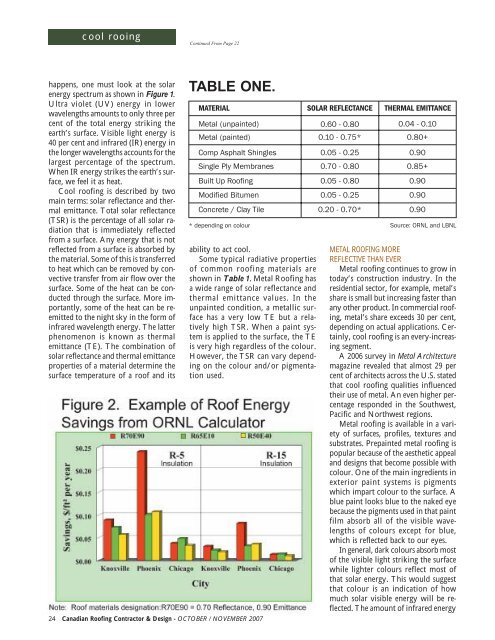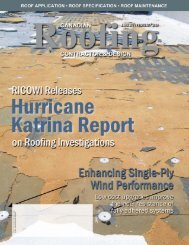here - Perks Publications Inc.
here - Perks Publications Inc.
here - Perks Publications Inc.
Create successful ePaper yourself
Turn your PDF publications into a flip-book with our unique Google optimized e-Paper software.
cool rooing<br />
Continued From Page 22<br />
happens, one must look at the solar<br />
energy spectrum as shown in Figure 1.<br />
Ultra violet (UV) energy in lower<br />
wavelengths amounts to only three per<br />
cent of the total energy striking the<br />
earth’s surface. Visible light energy is<br />
40 per cent and infrared (IR) energy in<br />
the longer wavelengths accounts for the<br />
largest percentage of the spectrum.<br />
When IR energy strikes the earth’s surface,<br />
we feel it as heat.<br />
Cool roofing is described by two<br />
main terms: solar reflectance and thermal<br />
emittance. Total solar reflectance<br />
(TSR) is the percentage of all solar radiation<br />
that is immediately reflected<br />
from a surface. Any energy that is not<br />
reflected from a surface is absorbed by<br />
the material. Some of this is transferred<br />
to heat which can be removed by convective<br />
transfer from air flow over the<br />
surface. Some of the heat can be conducted<br />
through the surface. More importantly,<br />
some of the heat can be reemitted<br />
to the night sky in the form of<br />
infrared wavelength energy. The latter<br />
phenomenon is known as thermal<br />
emittance (TE). The combination of<br />
solar reflectance and thermal emittance<br />
properties of a material determine the<br />
surface temperature of a roof and its<br />
TABLE ONE.<br />
ability to act cool.<br />
Some typical radiative properties<br />
of common roofing materials are<br />
shown in Table 1. Metal Roofing has<br />
a wide range of solar reflectance and<br />
thermal emittance values. In the<br />
unpainted condition, a metallic surface<br />
has a very low TE but a relatively<br />
high TSR. When a paint system<br />
is applied to the surface, the TE<br />
is very high regardless of the colour.<br />
However, the TSR can vary depending<br />
on the colour and/or pigmentation<br />
used.<br />
24 Canadian Roofing Contractor & Design - OCTOBER / NOVEMBER 2007<br />
MATERIAL SOLAR REFLECTANCE THERMAL EMITTANCE<br />
Metal (unpainted)<br />
Metal (painted)<br />
Comp Asphalt Shingles<br />
Single Ply Membranes<br />
Built Up Roofing<br />
Modified Bitumen<br />
Concrete / Clay Tile<br />
0.60 - 0.80 0.04 - 0.10<br />
0.10 - 0.75*<br />
0.80+<br />
0.05 - 0.25<br />
0.70 - 0.80<br />
0.05 - 0.80<br />
0.05 - 0.25<br />
0.20 - 0.70*<br />
0.90<br />
0.85+<br />
0.90<br />
0.90<br />
0.90<br />
* depending on colour Source: ORNL and LBNL<br />
METAL ROOFING MORE<br />
REFLECTIVE THAN EVER<br />
Metal roofing continues to grow in<br />
today’s construction industry. In the<br />
residential sector, for example, metal’s<br />
share is small but increasing faster than<br />
any other product. In commercial roofing,<br />
metal’s share exceeds 30 per cent,<br />
depending on actual applications. Certainly,<br />
cool roofing is an every-increasing<br />
segment.<br />
A 2006 survey in Metal Architecture<br />
magazine revealed that almost 29 per<br />
cent of architects across the U.S. stated<br />
that cool roofing qualities influenced<br />
their use of metal. An even higher percentage<br />
responded in the Southwest,<br />
Pacific and Northwest regions.<br />
Metal roofing is available in a variety<br />
of surfaces, profiles, textures and<br />
substrates. Prepainted metal roofing is<br />
popular because of the aesthetic appeal<br />
and designs that become possible with<br />
colour. One of the main ingredients in<br />
exterior paint systems is pigments<br />
which impart colour to the surface. A<br />
blue paint looks blue to the naked eye<br />
because the pigments used in that paint<br />
film absorb all of the visible wavelengths<br />
of colours except for blue,<br />
which is reflected back to our eyes.<br />
In general, dark colours absorb most<br />
of the visible light striking the surface<br />
while lighter colours reflect most of<br />
that solar energy. This would suggest<br />
that colour is an indication of how<br />
much solar visible energy will be reflected.<br />
The amount of infrared energy










